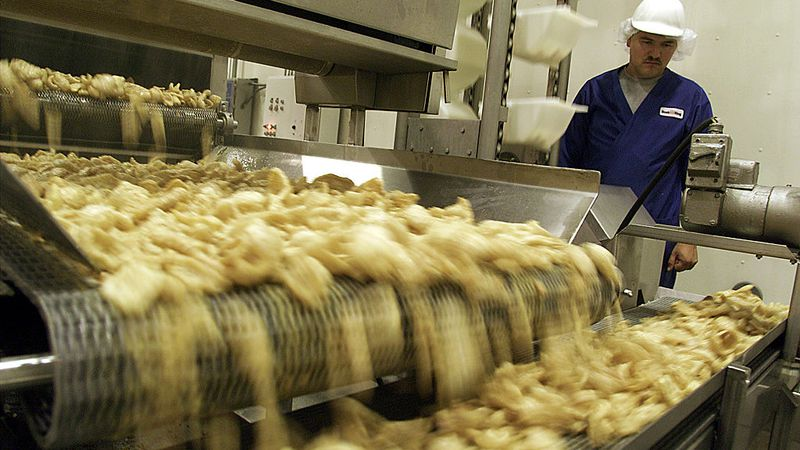How Are Pork Rinds Made?
If you've ever eaten pork skin at a pig roast, you'll notice it's chewy and gummy—sort of the textural opposite of pork rinds you find in convenience stores. So how does one transform pork skin to those crackly, puffy, aerated snacks?
Simmering pork skin in boiling water is the first step. Then, they're divided into bite-size pieces known in the trade as "pellets," then chilled at least four hours so that the subdermal fat can solidify.
After that layer has congealed, it is pared away and discarded. This is what separates rinds from cracklins, the pork rind's crunchier, comparatively more artery-clogging sibling.
Bereft of their fat, the pellets are dried and rendered to remove as much moisture as possible. These individual proto-rinds are placed across a mesh tray over a drip pan, then left in a low-heat oven for about eight hours. Larger operations such as Rudolph Foods, whose Lima, Ohio, factory churns out 100 million pounds of pork rinds a year, often use industrial-size dehydrators. Either way, this is the most important step in making a good batch of pork rinds. Only a small amount of water needs to be retained to give the snack its identifiable puffiness.
Once the skin is dried, it's ready for frying. Oil—peanut, vegetable, even lard works, as long as it possesses a high smoking point—should be heated to about 360 degrees, and then the slices can be submerged. What little moisture is left in the skin evaporates soon after hitting the hot oil, expanding the nooks and crannies as it fries. The rinds will sink at first, and it's important to ensure they don't settle in the pan.
"If you don't stir, it'll stick to the bottom and burn," says Kristopher Doll, owner of Shank Charcuterie in New Orleans, himself a regular pork rind maker. "You'll end up with a gnarly, hard chunk."
After about 15 seconds, the pellets audibly crackle like popcorn, and cooks need to make sure that the entirety of the skin gets exposed to the deep frying, otherwise you're just left with gummy bits of oil-sodden rubberiness.

As is standard practice with most deep-fried foods, pork rinds need to be seasoned immediately after frying while they're still slightly damp and hot, so the spices will stick to its surface. Once the snacks are cooled, they can finally be consumed en masse.
And en masse they are certainly consumed. Since 1997, annual pork rind profits have increased to $400 million from $300 million, according to ABC News. Many attribute this rise in popularity at least partially to the various low-carb diet crazes—maybe not so coincidentally, the Atkins diet hit the market the same year as the first rise of pork rind sales.
But marketing on pork rinds' appeal of low carbs is sort of like praising fried chicken for its low sugar content. Yes, a half-ounce serving of Rudolph's pork rinds contains no carbohydrates, but makes up for it in 5 grams of fat and 80 calories. Which means a standard bag of pork rinds is the fat and caloric equivalent of a McDonald's Big Mac.
